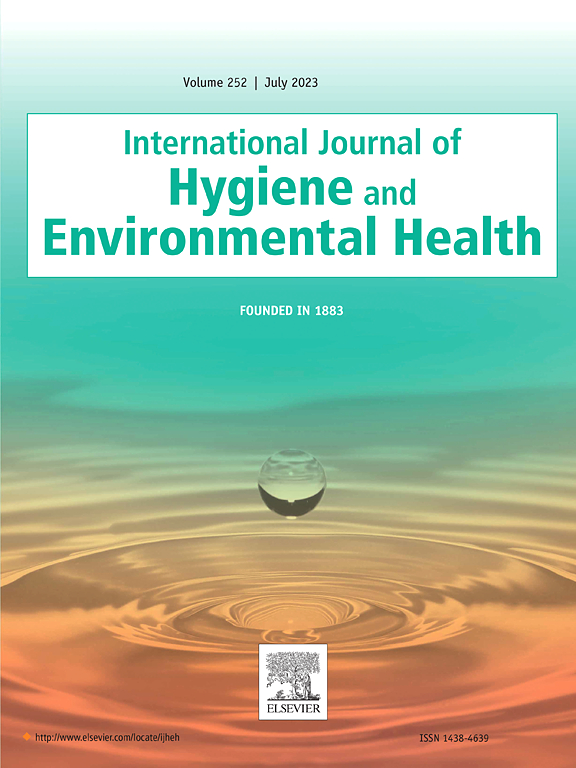Predictors of household drinking water E. coli contamination: Population-based results from rural areas of Ghana, Malawi, Mozambique, Niger, Rwanda, Uganda, and Zambia
IF 4.4
2区 医学
Q1 INFECTIOUS DISEASES
International journal of hygiene and environmental health
Pub Date : 2024-12-10
DOI:10.1016/j.ijheh.2024.114507
引用次数: 0
Abstract
Background
In sub-Saharan Africa, rural areas have lower rates of access to safe drinking water compared to urban areas. We investigated predictors of Escherichia coli contamination in drinking water of rural households in Ghana, Malawi, Mozambique, Niger, Rwanda, Uganda, and Zambia.
Methods
We used a population-based, cluster randomized sampling design to select rural households in each country. Household interviews on water access, sanitation, and hygiene (WaSH) practices and demographic characteristics were conducted and water samples from every fifth household were collected and enumerated for E. coli. Negative binomial regression models with survey sampling weights were run to evaluate predictors of E. coli contamination.
Results
A total of 18,747 rural household surveys (2,378–2,804 per country) were conducted and a total of 3,848 water samples (460–660 per country) were collected. Of surveyed rural households, 61–78% of households had high (11–100 E. coli cfu/100 mL) or very high (>100 cfu/100 mL) risk water quality in Ghana, Niger, and Uganda. Statistically significant WaSH predictors associated with lower E. coli incidence rates included using an improved-type primary water source (Mozambique), storing water in a narrow-mouthed container or container with a spigot (Niger), having continuous water supply during the dry season (Ghana), paying for water service (Rwanda), having soap or ash at handwashing points (Mozambique), having an improved-type household sanitation facility (Malawi), and attaining an education level greater than primary school (Niger and Zambia).
Conclusion
This study highlights the variability in WaSH access between rural areas of the study countries in association with microbial drinking water quality.
家庭饮用水大肠杆菌污染的预测因素:加纳、马拉维、莫桑比克、尼日尔、卢旺达、乌干达和赞比亚农村地区基于人口的结果。
背景:在撒哈拉以南非洲,与城市地区相比,农村地区获得安全饮用水的比例较低。我们调查了加纳、马拉维、莫桑比克、尼日尔、卢旺达、乌干达和赞比亚农村家庭饮用水中大肠杆菌污染的预测因素。方法:我们采用以人口为基础的整群随机抽样设计,在每个国家选择农村家庭。进行了关于水获取、环境卫生和个人卫生(WaSH)做法和人口特征的家庭访谈,并从每五户家庭收集水样并枚举大肠杆菌。采用调查抽样权的负二项回归模型评价大肠杆菌污染的预测因子。结果:共进行了18747次农村住户调查(每个国家2378 - 2804次),共收集了3848份水样(每个国家460-660份)。在接受调查的加纳、尼日尔和乌干达农村家庭中,61-78%的家庭存在高(11-100 cfu/100 mL)或非常高(100 -100 cfu/100 mL)风险水质。与大肠杆菌发病率较低相关的具有统计意义的WaSH预测因素包括:使用改进型主要水源(莫桑比克)、将水储存在窄口容器或带水龙头的容器中(尼日尔)、在旱季有连续供水(加纳)、支付水服务费用(卢旺达)、在洗手点有肥皂或灰(莫桑比克)、拥有改进型家庭卫生设施(马拉维)、达到小学以上的教育水平(尼日尔和赞比亚)。结论:本研究强调了研究国家农村地区之间WaSH获取的可变性与微生物饮用水质量的关系。
本文章由计算机程序翻译,如有差异,请以英文原文为准。
求助全文
约1分钟内获得全文
求助全文
来源期刊
CiteScore
11.50
自引率
5.00%
发文量
151
审稿时长
22 days
期刊介绍:
The International Journal of Hygiene and Environmental Health serves as a multidisciplinary forum for original reports on exposure assessment and the reactions to and consequences of human exposure to the biological, chemical, and physical environment. Research reports, short communications, reviews, scientific comments, technical notes, and editorials will be peer-reviewed before acceptance for publication. Priority will be given to articles on epidemiological aspects of environmental toxicology, health risk assessments, susceptible (sub) populations, sanitation and clean water, human biomonitoring, environmental medicine, and public health aspects of exposure-related outcomes.

 求助内容:
求助内容: 应助结果提醒方式:
应助结果提醒方式:


